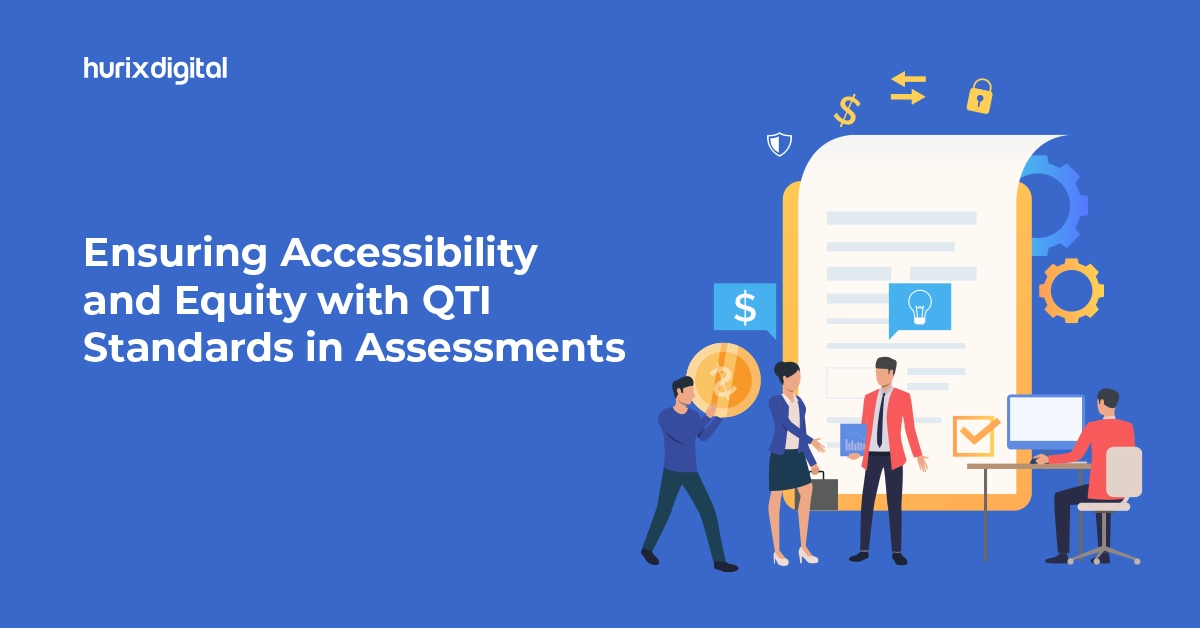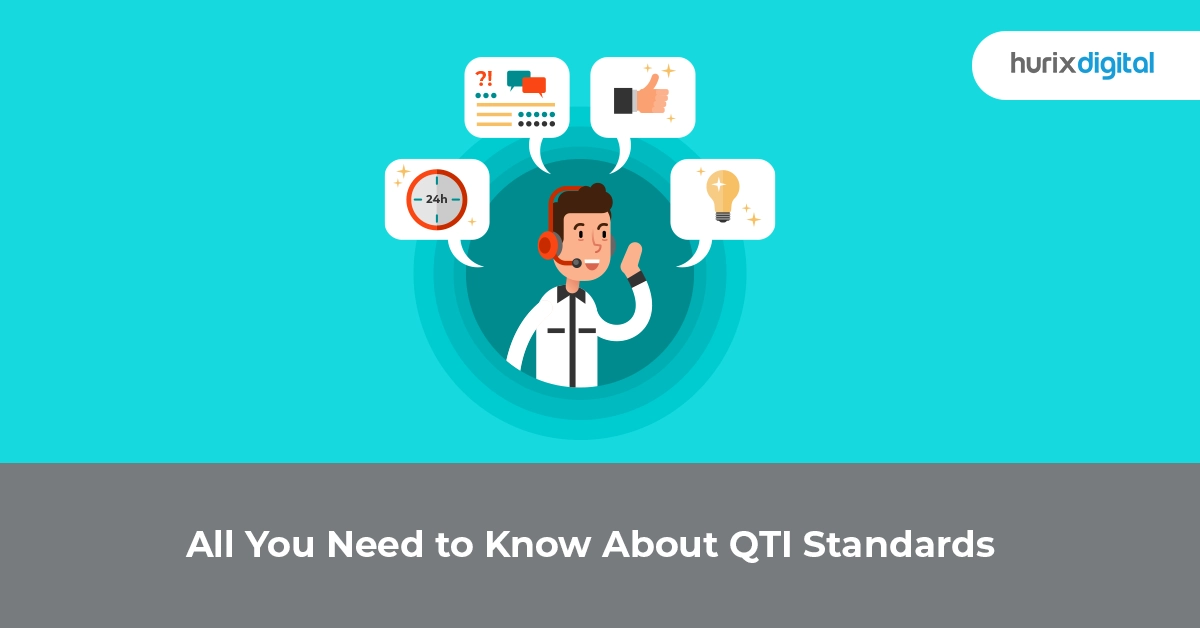
Ensuring Accessibility and Equity with QTI Standards in Assessments
Summary
Discover how QTI standards can support accessibility and equity in assessments. This blog discusses how adhering to QTI standards ensures fair and inclusive evaluation practices.
The shift to online learning in the last few years has increased the need for interoperability and accessibility more than ever before. In this regard, establishing a robust technology infrastructure built upon well-established and widely adopted standards is essential to achieving seamless interoperability in this digital era. This is where QTI standards in assessments come in.
Question and Test Interoperability (QTI) refers to a set of standards around the format of import/export files for test or exam questions in educational assessment exams. It helps facilitate the easy movement of questions from one software platform to another, including test assembly, eLearning, training, and exam delivery.
In this post, we will explore more about QTI Standards and highlight various ways you can leverage them to enhance online learning experiences. Let’s start!
Table of Contents:
- Understanding the QTI Standard
- Importance of QTI Standards in Assessments
- Best Practices for Creating QTI-Compliant Assessments
- Wrapping Up
Understanding the QTI Standard
The standard used the most for marking up tests, exams, quizzes, and assessments is called Question and Test Interoperability, or QTI. QTI is essentially a zip file including quiz data in XML format together with related multimedia files.
The standard identifies and defines everything from the formats, and protocols to the points of interoperability that save users and suppliers time and money in the development, delivery, and outcomes of assessments.
The QTI standard also supports compliance with various federal requirements to meet the needs of all learners and students, as mentioned in Section 508 of the Rehabilitation Act of 1973 and Section 508, which requires WCAG 2.0 AA compliance. The most recent versions of QTI also support accommodations commonly used in K–12 assessments.
Also Read: Building Better Tests: Tips and Tricks for Effective Use of Assessment Authoring Tools
Importance of QTI Standards in Assessments
QTI Standards help educators efficiently navigate several challenges, such as:
1. Improves Accessibility
Educators across institutions today face the challenge of a lack of standardized formats, which creates barriers regarding specific accessibility features. QTI standards address this need and ensure that assessments are accessible to all learners, regardless of their abilities.
Put simply, QTI is specifically designed to support accessibility standards, thus making assessments much more inclusive for all students, including those with various disabilities.
By adhering to these accessibility guidelines set by QTI standards, educational institutions can ensure that their assessments are fair and effective in evaluating student knowledge.
2. Enhances Equity and Adaptability
With different educational institutions utilizing various tools and systems, there is a need to allow for equity and more adaptability in diverse learning environments. QTI standards ensure that assessment content remains adaptable across these diverse learning environments.
In addition to this, QTI assessments support a wide range of question types, including multiple-choice questions, short answers, true/false, and more. This kind of adaptability allows educators to create diverse and engaging assessments for students that cater to varied learning styles and subject matter.
3. Higher Efficiency
QTI.30 standards help you eliminate the manual, time-consuming process of transferring assessment content between different systems, thus significantly improving efficiency.
In addition to saving teachers a great deal of time, it enables them to keep the assessment’s integrity throughout the transfer process and supports them in developing adaptive exams that are dependent on the performance of each student. This also means that assessments can be customized based on individual learner’s strengths and weaknesses, which allows them to improve their subject knowledge and retention with time.
4. Paperless Assessments
Another benefit of QTI compliance for assessments is the ability of educational institutions to switch from paper-based tests to digital assessments.
This can result in significant savings in terms of money, time, and implementation. QTI compliance for assessments also facilitates the recording of actionable insights and data that enable educators to offer students customized learning based on their performance and achievement of their respective learning outcomes.
Best Practices for Creating QTI-Compliant Assessments
Here are some of the best practices for creating QTI-compliant assessment questions:
1. Offer Equal Opportunities to All Learners
When it comes to designing assessments, one of the top considerations should be to give all students an equal and fair opportunity to demonstrate their learning.
A few of the things to take into account here while creating a compliant assessment include:
- Validity: The test questions you include here should purposefully relate to your course content and the respective learning goals.
- Bias-Free: While creating test questions, it is best to not assume that learners already understand the type of language or slang you are using. The ideal option here is to use language that is completely free from bias and easy for all students.
- Time and Consistency: It is recommended that questions be designed so that all students have enough time to complete the exam. Similarly, the exam needs to be consistent so that students can achieve similar results if they have to retake it.
2. Adopt Progressive Question Structures
Another important thing to keep in mind while creating QTI-compliant exam questions is maintaining a progressive structure. Here are some of the things that you need to keep in mind:
- The exam questions that you come up with should flow in a progressive structure, starting with easier questions and gradually moving to more challenging ones.
- Maintaining a structure is important as it allows learners to answer a variety of different question types and also enables them to use these questions to build confidence as they move on to more challenging questions.
3. Select Appropriate Test Formats
Another important aspect to keep in mind while creating engaging test questions that are by QTI standards is determining the specific type of test format you are going to use.
Some of these test formats include multiple-choice questions,fill-in-the-blanks, true or false questions, and open-ended questions.
The ideal way to do this is to go with the format that best checks the cognitive abilities of students in the subject matter. For example, open-ended questions are best to add if you wish students to compare and contrast a topic.
Also Read: The Benefits of Using eLearning Authoring Tools for Faster Course Creation
Wrapping Up
QTI compliance for assessments is an excellent way to easily transition from paper-based to digital assessments, including simple quizzes, formative assessments, or summative assessments.
Apart from improving the overall assessment ecosystem by facilitating the seamless exchange of question items, tests, and results data between various authoring tools, learning environments, and scoring administrative systems, QTI standards also ensure accessibility and equity in assessments.
If you are looking to benefit from QTI compliance, Dictera by Hurix Digital is one of the best tools for assessment creation that fully adheres to the highest QTI standards. As an excellent AI and ML-powered QTI tool, it seamlessly allows educators to create assessments, collaborate in real-time, and derive meaningful, data-driven insights on learner performance.
Connect with us now to learn more about Dictera.

Currently, Serving as the Vice President of Technology and Principal architect at HurixDigital, a leader in edTech world. With 25 years of IT Services experience, I specialize in EdTech and various domains, focusing on digital transformations, integration, and AI/ML in education. My expertise drives innovative solutions and operational efficiency, leveraging cutting-edge technologies to meet industry needs.























